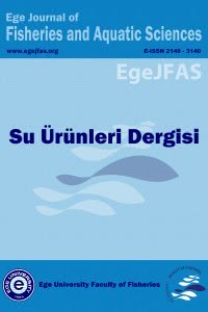Brachionus plicatilis (Rotifer) in farklı besin ortamlarında büyümesi
Rotifera, Spirulina, büyüme oranı, balık beslenmesi
Growth of Brachionus plicatilis (Rotifer) on various diets
Rotifera, Spirulina, growth rate, fish feeding,
___
Arnold, C.R., G.J. Holt, 1991. Various Methods for the Culture of the: Rotifer, Brachtonus plicatilis , in Texas In: W. Fulks and K. Main [Eds.], Rotifer and Microalgae Culture Systems. Proce Dings of a U:S. Asia, Honollulu, pp. 119-123.Chen, X.Q., L.J. Long, 1991. Research and Prodoction of Live Feeds in China. In: W. Fulks and K. Main [Eds.], Rotifer and Microalgae Culture Systems. Proce Dings of a U:S. Asia, Honollulu, pp. 187-201.
Fukusho, K., 1985. Status of Marine Larval Culture in Japon, in Ed. By. Lee C.S. and Liao, I.C., Reproduction and Culture of Milkfish, The Oceanic Institute and Tungkang Marine labaratory, pp. 127-139
Fulks, W., K.L. Main, 1991. Rotifer and Microalgae Culture Systems. Proceedings of a U.S.-Asia Workshop. Hawaii, pp.3-52
Hino, A., R. Hirano, 1984. Relationship Between Body Size of the Rotifer Brachionus plicatilis and the Maximum Size of Particles Ingested. Nippon Suisan Gakkaishi 46:1217-1222
Hirayama, K., H. Funamoto, 1983. Supplementary Effect of Several Nutrients on Nutritive Deficiency of Baker's Yeast for Population Growth of the . Rotifer Brachionus plicatilis, Bull. Of the Jap. Sci. Of Scien. Fish, 49(4): 505-510.
Hirayama, K, I. Maruyama, T. Maeda, 1989. Nutritional Effect of Freshwater Chlorella on Growth of the Rotifer Brachionus plicatilis. Hydrobiologia, 186-187:39-42.
Hoff, H, T.W. Snell, 1987. Plankton Culture Manual, Florida Aqua Farms, Inc., 125p
Hoff, H., T.W. Snell, 1989. Plankton Culture Manual. 2nd Edition. Florida Aqua. Farms, Florida, pp. 126.
James, CM, P. Dias, A.E. Salman, 1987. The use of Marinae Yeast (Candida) and Baker's Yeast (Saccharomyces) in Combination With Clorella sp. For the Rotifer Brachionus plicatilis. Hydrobiologia, 147:263- 268.
Kissil, G.Wn, W.M. Kovan, 1989. Preparation of oils Enhanced in Higly Unsatureted Fatty Acid (HUFA) Content, by Low Temperature Crystallization Seperation, For Rotifer Brachionus plicatilis Enrichment, Aquaculture, 88:69-77
Kongkeo, H., 1991. An Overview of Live feeds Production Systems Desing in Thailand. In: Fulks, W., Main, K. Rotifer and Microalgae Culture Systems. Proce Dings of a U:S. Asia, Honoliulu, pp. 175-186
Korstad, J., O. Vadstein, Y. Olsen, 1989. Feeding Kinetics of Brachionus plicatilis Fed Isochrysis golbana. Hydrobiologia 186/187. pp. 51-57.
Lubzens, E ., 1987. Raising Rotifers For Use in Aquaculture. Hydrobiologia. 147:245-255.
Lubzens, E., G. Minkoff, S. Marom, 1985. Salinity Dependence of Sexual and Asexual Reproduction in the Rotifer Brachionus plicatilis Mar. Biol. 85: 123-126,
Lubzens, E,, A. Tandler, G. Minkoff, 1989. Rotifer as Feed in Aquaculture, Hydrobiologia, 186-187:387-400
Santillan, C, 1982. Mass production of Spirulina. Experientia 38:40-43.
Snell, T.W., 1991. Improving the Desing of Mass Culture Systems for the Rotifer Brachionus plicatilis. In: Fulks, W., K. Main [Eds.], the Rotifer and Microalgae Culture Systems Proce Dings of a U.A. Asia, Honoliulu. Pp. 61-71.
Yasuda, K., N. Taga, 1980. Culture of Brachionus plicatilis Müller using bacteria as food, Bull.of the Jap. Soc. of Scient. Fish.. 46 (8): 993 - 939.
- ISSN: 1300-1590
- Yayın Aralığı: 4
- Başlangıç: 1984
- Yayıncı: Aynur Lök
Eğirdir Gölü (Isparta)' nün doğal yapısına yapılan müdahalelerin gölün ekolojik yapısına etkileri
Balık larvalarının beslenmesinde kullanılan mikropartikül yemler ve potansiyelleri
Pasif av araçları ile avcılıkta balık davranışları
Balık üretiminden kaynaklanan kirlilik ve çözüm yolları
Ahmet Adem TEKİNAY, DERYA GÜROY, Nazan ÇEVİK
Z. Arzu Becer ÖZVAROL, B. Ahmet BALCI, MEHMET ÖZBAŞ, Mehmet GÖKOĞLU, Hayri GÜLYAVUZ, Ayşe TAŞLI, Meltem PEHLİVAN, Yasemin KAYA
Bartın Çayı (Bartın) Havzası' nın Ephemeroptera (Insecta) limnofaunası
Mustafa TANATMIŞ, NESİL ERTORUN
M. Emin ERDEM, Ferhat KALAYCI, Necati SAMSUN
Çanakkale Boğazı ve civarında yakalanan istavrit balığının bazı biyolojik özellikleri
